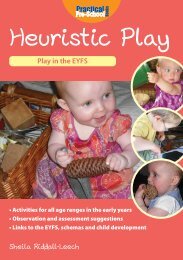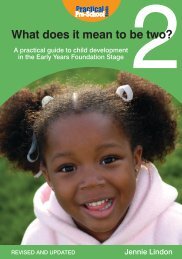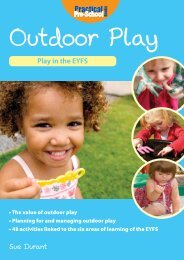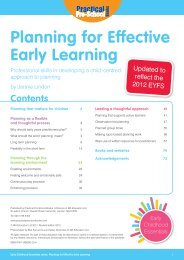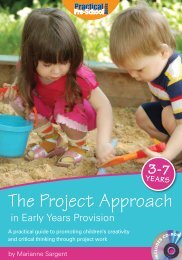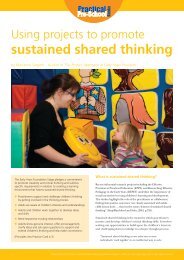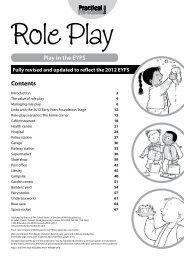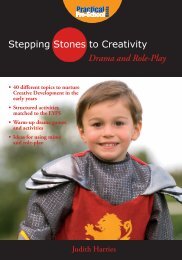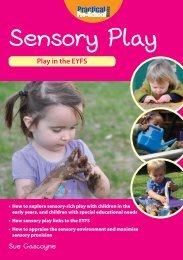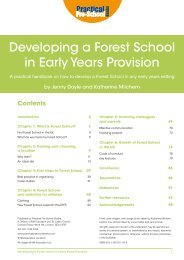What does it mean to be one? - Practical Pre-School Books
What does it mean to be one? - Practical Pre-School Books
What does it mean to be one? - Practical Pre-School Books
Create successful ePaper yourself
Turn your PDF publications into a flip-book with our unique Google optimized e-Paper software.
Where are the <strong>one</strong>s in terms of early years provision?<br />
This book covers the baby year up <strong>to</strong> the first birthday and in<strong>to</strong> the year in which <strong>to</strong>ddlers are<br />
<strong>one</strong>. A huge amount happens developmentally over this time span and some babies and <strong>to</strong>ddlers<br />
will remain the full responsibil<strong>it</strong>y of their own family: parents or other adult family mem<strong>be</strong>rs.<br />
However, over the first part of very early childhood, some babies and <strong>to</strong>ddlers will experience the<br />
trans<strong>it</strong>ion in<strong>to</strong> some kind of non-family care, for part or all of their week.<br />
• Some of this age group will <strong>be</strong> cared for by somebody other than their parents, but<br />
w<strong>it</strong>hin a family home: by a nanny employed by the family <strong>to</strong> work in their home or<br />
w<strong>it</strong>h a childminder who is based in her, or occasionally his, own family home.<br />
• Other under <strong>one</strong>s and <strong>one</strong>s spend time in a group setting: a day nursery or a<br />
children’s centre. Unless the setting is very small, the under twos (often under<br />
threes) are likely <strong>to</strong> <strong>be</strong> in a separate base room from the over threes.<br />
Up <strong>to</strong> 2002 all national guidance across the UK was focussed on the over threes. England,<br />
Scotland and Wales each had their own early years curriculum document <strong>to</strong> guide pract<strong>it</strong>i<strong>one</strong>rs<br />
working w<strong>it</strong>h three- <strong>to</strong> five-year-olds. The framework for Northern Ireland covered three- and<br />
four-year-olds, since young children start primary school in the Septem<strong>be</strong>r of the school year after<br />
their fourth birthday. Any guidance about good practice w<strong>it</strong>h under threes was developed w<strong>it</strong>hin<br />
a local area by early years teams who were concerned about guiding or enhancing the qual<strong>it</strong>y of<br />
provision. Then, in 2002 the Birth <strong>to</strong> Three Matters framework was introduced in England, and in<br />
2005 Scotland launched their Birth <strong>to</strong> Three: Supporting our Youngest Children framework.<br />
The most recent changes are that:<br />
• In England from Septem<strong>be</strong>r 2008 the birth <strong>to</strong> five Early Years Foundation Stage<br />
(EYFS) has replaced both the under-threes Birth <strong>to</strong> Three Matters, and the Foundation<br />
Stage for three-<strong>to</strong> five-year-old.<br />
• In Scotland, the current developments for change revolve around a Curriculum for<br />
Excellence set <strong>to</strong> cover all children from three <strong>to</strong> eighteen years of age. In the earlier<br />
years, the main focus for development is for a continu<strong>it</strong>y of more active learning and<br />
play from the early education of three-<strong>to</strong> five-year-olds in<strong>to</strong> the first years of primary<br />
school. The Scottish birth <strong>to</strong> three guidance remains the framework for good<br />
practice w<strong>it</strong>h this youngest age range.<br />
• In Wales, the main focus of development is on the Foundation Phase for young<br />
children from three <strong>to</strong> seven years, bridging the early years curriculum in<strong>to</strong> the first<br />
years of primary school. There is no national under threes guidance in Wales.<br />
• In Northern Ireland the early years curriculum applies <strong>to</strong> three- and four-year-olds,<br />
often mainly threes. There is no national under threes guidance and the main focus<br />
for current development has <strong>be</strong>en the Foundation Stage that applies <strong>to</strong> the first two<br />
years of primary school, w<strong>it</strong>h children aged four or five years of age. However, over<br />
2009 the Department of Education is working on an early years strategy for the age<br />
span of birth <strong>to</strong> six years.<br />
The English and Scottish under threes materials had a different appearance and overall structure,<br />
but otherwise they had a great deal in common, <strong>be</strong>cause the teams drew on the same source<br />
materials, including research about very early development. These strands for good practice now<br />
run throughout the 0-5 EYFS as consistent themes in developmentally appropriate practice: the<br />
importance of secure attachment w<strong>it</strong>hin early childhood, that making a personal relationship w<strong>it</strong>h<br />
children is a non-negotiable part of early years professionalism and that nurture is an essential<br />
part of good and safe practice.<br />
<strong>What</strong><br />
<strong>does</strong><br />
<strong>it</strong> <strong>mean</strong> <strong>to</strong><br />
<strong>be</strong><br />
<strong>one</strong>?<br />
<br />
<strong>What</strong><br />
<strong>does</strong><br />
<strong>it</strong> <strong>mean</strong><br />
<strong>to</strong><br />
<strong>be</strong><br />
<strong>one</strong>?




